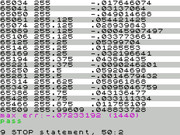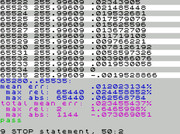Code: Select all
MULTAB DB 0, 0, 1, 2, 4, 6, 9, 12, 16, 20
DB 25, 30, 36, 42, 49, 56, 64, 72, 81, 90
DB 100, 110, 121, 132, 144, 156, 169, 182, 196, 210
DB 225, 240, 0, 16, 33, 50, 68, 86, 105, 124
DB 144, 164, 185, 206, 228, 250, 17, 40, 64, 88
DB 113, 138, 164, 190, 217, 244, 16, 44, 73, 102
DB 132, 162, 193, 224, 0, 32, 65, 98, 132, 166
DB 201, 236, 16, 52, 89, 126, 164, 202, 241, 24
DB 64, 104, 145, 186, 228, 14, 57, 100, 144, 188
DB 233, 22, 68, 114, 161, 208, 0, 48, 97, 146
DB 196, 246, 41, 92, 144, 196, 249, 46, 100, 154
DB 209, 8, 64, 120, 177, 234, 36, 94, 153, 212
DB 16, 76, 137, 198, 4, 66, 129, 192
DB 0, 192, 129, 66, 4, 198, 137, 76, 16, 212
DB 153, 94, 36, 234, 177, 120, 64, 8, 209, 154
DB 100, 46, 249, 196, 144, 92, 41, 246, 196, 146
DB 97, 48, 0, 208, 161, 114, 68, 22, 233, 188
DB 144, 100, 57, 14, 228, 186, 145, 104, 64, 24
DB 241, 202, 164, 126, 89, 52, 16, 236, 201, 166
DB 132, 98, 65, 32, 0, 224, 193, 162, 132, 102
DB 73, 44, 16, 244, 217, 190, 164, 138, 113, 88
DB 64, 40, 17, 250, 228, 206, 185, 164, 144, 124
DB 105, 86, 68, 50, 33, 16, 0, 240, 225, 210
DB 196, 182, 169, 156, 144, 132, 121, 110, 100, 90
DB 81, 72, 64, 56, 49, 42, 36, 30, 25, 20
DB 16, 12, 9, 6, 4, 2, 1, 0
DB 0, 0, 0, 0, 0, 0, 0, 0, 0, 0
DB 0, 0, 0, 0, 0, 0, 0, 0, 0, 0
DB 0, 0, 0, 0, 0, 0, 0, 0, 0, 0
DB 0, 0, 1, 1, 1, 1, 1, 1, 1, 1
DB 1, 1, 1, 1, 1, 1, 2, 2, 2, 2
DB 2, 2, 2, 2, 2, 2, 3, 3, 3, 3
DB 3, 3, 3, 3, 4, 4, 4, 4, 4, 4
DB 4, 4, 5, 5, 5, 5, 5, 5, 5, 6
DB 6, 6, 6, 6, 6, 7, 7, 7, 7, 7
DB 7, 8, 8, 8, 8, 8, 9, 9, 9, 9
DB 9, 9, 10, 10, 10, 10, 10, 11, 11, 11
DB 11, 12, 12, 12, 12, 12, 13, 13, 13, 13
DB 14, 14, 14, 14, 15, 15, 15, 15
DB 16, 15, 15, 15, 15, 14, 14, 14, 14, 13
DB 13, 13, 13, 12, 12, 12, 12, 12, 11, 11
DB 11, 11, 10, 10, 10, 10, 10, 9, 9, 9
DB 9, 9, 9, 8, 8, 8, 8, 8, 7, 7
DB 7, 7, 7, 7, 6, 6, 6, 6, 6, 6
DB 5, 5, 5, 5, 5, 5, 5, 4, 4, 4
DB 4, 4, 4, 4, 4, 3, 3, 3, 3, 3
DB 3, 3, 3, 2, 2, 2, 2, 2, 2, 2
DB 2, 2, 2, 1, 1, 1, 1, 1, 1, 1
DB 1, 1, 1, 1, 1, 1, 1, 0, 0, 0
DB 0, 0, 0, 0, 0, 0, 0, 0, 0, 0
DB 0, 0, 0, 0, 0, 0, 0, 0, 0, 0
DB 0, 0, 0, 0, 0, 0, 0, 0
Because I noticed there's A LOT of redundancy in that table. The 128th entry is 0 and entries 129-255 seem to just be the values from index 127 to index 1? (i.e. entry 129+k = entry 127-k)
Same for the high byte... 128th entry is 16, and it's then the same entries in reverse order?
You could special case the 128th and 256+128th entry (hardcode them) and halve the size of the table (slight speed hit though)? Or you could fill the redundant data with other data or code instead if you want high byte to still be at offset base + 256 (it is a good idea to do that though)
I didn't check that the pattern definitely holds but it certainly looks like it to me. So it's kind of like how you only really need 1/4 of a sine lookup table since you can use symmetry for the remaining entries.
EDIT: Or is that because he is storing negative squares as well? In which case that is silly lol
It doesn't make sense for the table to be symmetric for x^2/4. Double the domain size instead lol. It looks like that is what he is doing. Noooooooooooooob alert. His routine is nice and fast though lol
EDIT2: So ignore what I said pre-edit, he's just done his table in a very wasteful manner there.
You also don't really need to store an entry for 0 either just special case that? Then you can use the full domain since 255^2 < 65536. You could also special case 1 since multiplying by 1 or 0 is pointless really the answer can be returned immediately (again, slight speed hit). (duh you can use the full domain anyway since you have 256 entries to play with... it's probably worth special casing/not even bothering calling the multiply function if one of the arguments is 0 or 1 though?). If you know either 0 or 1 or both will never be one of the arguments, even better, don't check. All you save is some bytes in the table you can use for other variables though.

